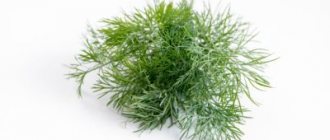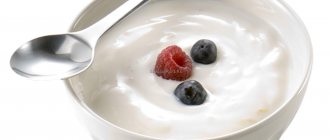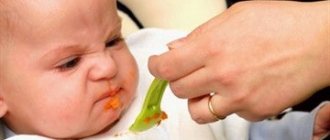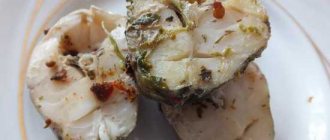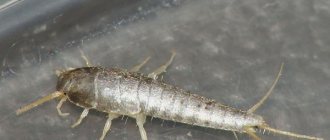When can you give a banana to your baby?
A pressing question from new parents: how to determine when it’s time to introduce your baby to a foreign fruit?
To begin with, it is important to pay attention to the fact that banana should not be the first food. With its sweet taste and delicate texture, this fruit can discourage a child from eating anything else, even mother's milk.
Therefore, introduce bananas into the diet after the baby is already familiar with apples and pears, cereals and vegetable purees. This should happen after six months of the child’s life, when his digestive system is ready to digest new foods.
The optimal age for banana feeding is 8 months.
In what form should bananas be given at an early age?
For the first time, the child is given a so-called squeezed banana. To do this, a small amount of fruit is placed in clean gauze or bandage and squeezed out. This makes delicious and healthy homemade puree.
Banana puree
A baby at six months of age crushes the fruit (a masher is used for this). Some doctors advise boiling a banana for a child. This is necessary for better absorption of the fruit. Dried banana fruits and exotic canned food should not be given to a child.
Important! The toddler should only be given ripe fruit. Eating unripe fruits can cause choking.
When can you give pieces?
A banana can be chopped into pieces for a child by the age of one year. At this time, his digestive system is already formed. From one year onwards it is allowed to give the whole fruit.
Benefit
Banana is a nutritious food. According to research, it contains a bit of joy. Namely, the hormone serotonin.
Bananas also contain proteins, amino acids, and carbohydrates. The biochemical composition of the fruit is varied. It is rich in tryptophan, lysine, methionine. Banana has a positive effect on all body systems, strengthening muscles, heart, liver and brain function.
Banana saturates the body with energy, thanks to fiber and starch, and helps improve the composition of the microflora of the gastrointestinal tract.
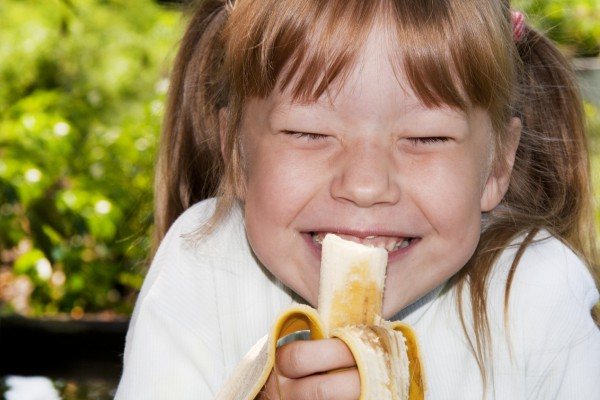
Vitamins B and C increase immunity, so why give your child any pills? You can protect him from colds by using vitamins from food, which are absorbed by the body faster and more reliably.
The banana is quite soft. And this is great for the child. Eating an exotic dessert will serve as a good exercise for developing chewing skills.
About the benefits of tropical fruit
The first question that needs to be answered is: “Is a banana even necessary in the human diet?” The answer is clear: “We need it!”
Banana contains a whole storehouse of vitamins:
- fiber, which ensures healthy intestinal function;
- B vitamins that strengthen the nervous system;
- Vitamin C is the best friend of a strong immune system;
- potassium, chlorine, calcium, phosphorus, magnesium are microelements necessary for the normal functioning of the cardiovascular system, muscles and bones of a person.
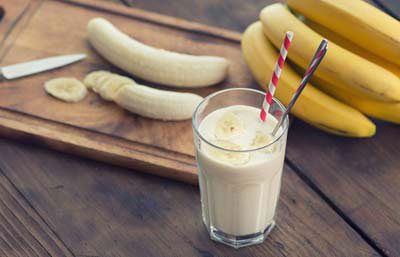
Banana cocktail
When should you not include banana in your diet?
- If the child is less than 6 months old. For his stomach, which is accustomed only to his mother's breast milk, a banana is difficult to digest.
- Allergies to bananas in children are rare. But it is worth remembering the individual tolerance of the products. For the first time, give your baby a minimum amount of fruit, and carefully monitor his body’s reaction. The formation of a rash or redness on a child’s body is a clear sign that this food is not for him.
- Bananas contain a high amount of natural sugar, so bananas are contraindicated for diabetic children.
- The nutritional value and calorie content of the fruit will not benefit babies who are prone to gaining excess weight.
If you have not found any contraindications to eating bananas, introduce them to your child (from the recommended age).
How to introduce into complementary foods
Banana should be introduced into a child’s diet in the form of a one-component puree, no earlier than 6 months for artificial babies and 8 months for children who are breastfed. It is best to give complementary foods in the morning, so they are better absorbed. In addition, you will have enough time to identify changes in the baby’s well-being before nightfall. Remember that for the first time you give your little one no more than half a spoon of liquid puree and only if it is tolerated normally, gradually increase the portion. If the slightest allergy occurs, immediately stop introducing bananas into your toddler’s diet.
To prepare puree for the first feeding, you will need:
- Peel the banana.
- Cut it into rings.
- Cook for a maximum of one minute. A water bath is best.
- Grind the banana until a homogeneous mass is formed.
- You can add a little breast milk or formula to the finished dish.
If you ask the question, can you give your child bananas every day? The answer is - it’s not advisable, even after a year. It is better to give this fruit no more than three times a week.
Choosing a quality product for complementary feeding
Only ripe fruit is suitable for your baby's diet. Parents can be fans of green bananas or very overripe ones without harm to their health. But for your baby, choose bright yellow fruits without dark spots or damage.

What are the dangers of an overripe banana?
The glucose level in a black banana is much higher, which is what can cause an allergic reaction in a baby.
Allergy to banana
Banana is a product with a moderate degree of allergenicity, so it is necessary to introduce it into a child’s complementary foods with caution.
Banana allergy is a hypersensitivity reaction to proteins present in bananas. An allergic reaction when eating a banana can be mild or life-threatening.
If you experience unpleasant symptoms after taking a banana or a food containing banana as a supplement, you should immediately consult a doctor.
Allergy to bananas is possible due to the presence of the protein chitinase. The human body is unable to destroy chitinase, and this forces the immune system to work, which produces antibodies to allergens. These antibodies further produce histamine, which affects different areas of the body such as the eyes, nose, gastrointestinal tract, lungs and skin to cause unwanted symptoms. This reaction is a type 1 allergy, a type of hypersensitivity created by the immune system. Banana protein is also present in avocados and kiwis, so it is not uncommon for those who are allergic to bananas to not react well to them.
Pollen is another possible cause of banana hypersensitivity. If your baby has an allergic reaction to birch pollen, the chances of an allergy to banana are much higher. In some cases, a banana allergy occurs when a child comes into contact with the fresh fruit. Although cooking bananas may reduce the risk of an allergic reaction in some children.
It is a surprising fact that latex can be a trigger for those who are allergic to banana. This is due to the natural level of chitinase in the rubber tree, the sap of which is used to make latex.
Many people confuse a banana allergy with a banana intolerance. However, these two concepts are not the same, although the symptoms they cause are quite similar. It should be noted that the symptoms of banana intolerance are usually milder than the symptoms of banana allergy. Under normal conditions, banana intolerance may take a few days to manifest itself. Moreover, banana allergy is more associated with the body's weakened immune system, while intolerance is associated with a weak digestive system.
Interestingly, not all people are allergic to green and ripe bananas. Some may be allergic only to green bananas and can still enjoy the delicious taste of ripe bananas without any problem. There are many people who are allergic to both types of bananas. In some cases, it has also been found that people outgrow allergic reactions at some point in their lives, but this is not the case for everyone. It's always best to consult a doctor to see if your child can continue eating bananas despite some allergy symptoms.
If a child has vomited after feeding banana, this is a fairly important sign of anxiety. Banana allergy in infants also causes a rash. Or, you may find that the skin around your baby's mouth is unusually reddish after feeding him banana.
Hives, eczema, or reddish spots may also appear. An itchy sensation is also common in infants. Sometimes the tongue becomes inflamed and the mouth and face become swollen. In many cases, symptoms may manifest themselves unambiguously or additionally as problems with the gastrointestinal tract. Monitor how your baby feels for several hours after feeding bananas. Some common symptoms are nausea, abdominal pain, diarrhea, gas and vomiting.
Some babies may experience respiratory symptoms after feeding banana, such as shortness of breath, chest tightness, crankiness, wheezing, stuffy or runny nose and cough. In severe cases, fainting is also possible.
Cooked bananas are believed to be less allergenic than raw bananas. When introducing bananas into complementary foods, you must follow the rule of waiting 4-7 days.
Banana with honey for cough for children
Due to its delicate texture, banana has an enveloping property, which is why it is often used to treat coughs. But the most valuable component in bananas in treating coughs is potassium. When combined, honey and banana pulp complement each other's beneficial properties in treating coughs.
A cough is often caused by a bacterial infection. And banana and honey have antibacterial properties. Once in the body, they disinfect the mucous membranes and relieve spasms. They also increase immunity and help the body cope with infection.
Banana-honey medicine - recipe
Take 1 banana and puree it with a blender or fork. Add half a tablespoon of honey. Then send this paste to a water bath - 10 minutes will be enough.
Take the product 3 times a day after meals.
For children 1-3 years old, half a teaspoon is enough, for children from 3 to 7 years old, the norm is 1 teaspoon. To completely get rid of cough, the course of taking the drug should be at least 7 days.
Banana dishes for children
Raw sweet bananas are very tasty and nutritious. A good option is dried. But there are other options that are no less healthy and tasty.
Pancakes
Ingredients
- banana – 2 pieces;
- milk – 80 ml;
- flour (oatmeal) – 100 grams;
- protein – 1 piece;
- salt - a pinch;
- vegetable oil for frying.
Preparation
Using a mixer, beat the egg whites and a pinch of salt until a slight foam forms. Cut the bananas into small pieces and add to the egg whites, beat.
Then gradually add milk and flour, keep whisking. The dough comes out a little thicker than sour cream. Fry the pancakes in a small amount of oil on both sides until golden brown.
This dish is especially delicious with orange juice or tea. Fresh, sour berries also go well with pancakes.
Oatmeal porridge
Ingredients
- cream – 150 grams;
- oatmeal – 3 tbsp. l.;
- banana - 1 piece;
- salt on the tip of a knife;
- butter – 1 tsp.
Preparation
If you are not using instant oatmeal, cook it according to the recipe, and 5 minutes before it is ready, pour the cream into the porridge. If you have instant cereal, first boil the cream and add oatmeal, salt and simmer for 7 minutes over low heat.
Mash the banana with a fork and add to the porridge. The finished porridge can be whipped in a mixer for an airy consistency. Add oil. You can serve with banana slices.
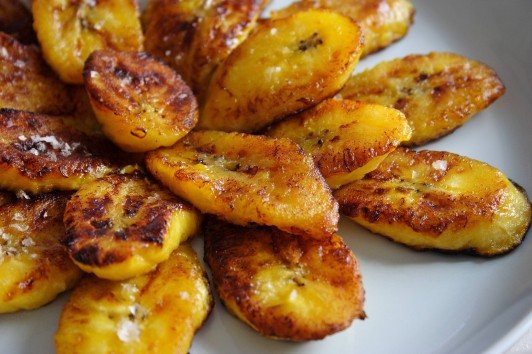
Banana based candies
Ingredients
- bananas – 1 (large);
- dates – 150 grams;
- prunes – 150 grams;
- cocoa – 3 tbsp.
Preparation
Prepare dried fruits by steaming them in hot water. Remove the pits from the dates and slice the banana. Blend all ingredients except cocoa powder with a blender until smooth.
Roll the mixture into balls or droplets and roll each candy in cocoa. Place in the refrigerator for half an hour.
Curd and banana dessert
Ingredients
- cottage cheese – 150 grams;
- banana – 4 pieces;
- chicken egg - 1 piece;
- honey - 1 tbsp. l.;
- butter – 30 grams;
- juice of half a lemon.
Preparation
Cut each banana in half lengthwise, place them on a baking sheet and sprinkle with lemon juice.
Mix cottage cheese, egg, honey and melted butter. Spread the mixture over the bananas.
In an oven preheated to 180 degrees, bake the dessert for 20 minutes until a beautiful golden hue forms.
